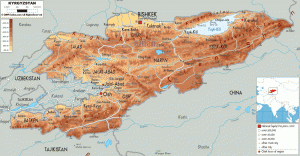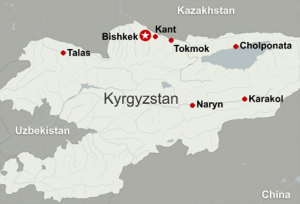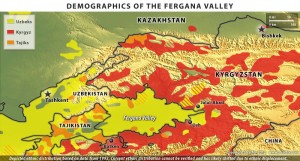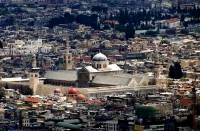Beforehand read: The male Nuland and the US’ Central Asian strategy
The first part of the article discussed Richard Miles’ Color Revolution credentials and why the arrival of the ‘Male Nuland’ in Bishkek likely portends an oncoming destabilization there. It also looked at American policy towards Uzbekistan and the importance of Ambassador Spratlen’s appointment to Tashkent. An overview of the US’ grand strategy against Russia, as adapted for the Central Asian vector, was also explored in that section. At this juncture, the article forecasts what the chaos that Miles is about to unleash in Kyrgyzstan will look like, including the tempting ‘media Crimea’ scenario that is bound to split Tashkent from Moscow and crown Uzbekistan as the US’ long-term Lead From Behind proxy in Central Asia.
The Kyrgyz Game Plan:
Zeroing in on Kyrgyzstan and Richard Miles’ ‘temporary’ appointment as the de-facto ambassador there, it’s likely that the general course of Color Revolutionary chaos will take on a relatively predetermined path. Parliamentary elections are scheduled for October, and will likely serve as ‘the event’ needed to ‘justify’ a Color Revolution. This is a very opportune time for the destabilization to commence, since Kyrgyzstan would have already joined the Eurasian Union, and ‘opposition’ candidates and/or activists can attempt to manipulate this into a campaign issue (either within the country or in front of the foreign media). Also, October represents the tail end of fall and the beginning of winter, which in Kyrgyzstan, leads to a de-facto months-long division between the North and the South owing to the blocking of critical mountain passes connecting the two.

With the country having almost split during the last spate of externally driven instability in 2010, the prospects remain for it to do so once more if there’s a repeat of similar violence. This is because the North-South Kyrgyzstan rivalry hasn’t gone away in the years since, but only went underground and outside of the international public’s attention. The emergence of ‘South Kyrgyzstan’ in fact or in form could become an epicenter of future conflicts and easily follow the Afghan model of drug trafficking and terrorism. These fears could create the conditions needed to force Russia and the CSTO into a Reverse Brzezinski intervention, made even more difficult by the mountainous terrain that favors insurgency over counter-guerrilla operations. Left to its own, ‘South Kyrgyzstan’s’ black hole of destabilization could combine with a renewed Taliban threat in Afghanistan to existentially endanger Tajikistan, which aside from further pressuring Russia to intervene and crush the fledgling ‘Central Asian Islamic State’, could raise fears in China that Uighur terrorists will exploit the disorder to establish bases for carrying out attacks in Xinjiang.
The entire dynamic would be complicated by the re-eruption of ethnic violence in Kyrgyzstan’s portion of the Fergana Valley, where the ethnic Uzbeks’ grievances and the tensions between them and ethnic Kyrgyz were simply swept under the rug for the past few years in the same way that the North-South Kyrgyzstan rivalry was. In the event that Miles succeeds in initiating any type of Color Revolution disorder in the country (which given its existing instability, isn’t that difficult to do), it’s expected that the 2010 ethnic chaos will return, when about 300,000 Uzbeks were displaced and 100,000 fled to Uzbekistan. This time, however, instead of Uzbekistan sitting on the sidelines and reacting to the crisis, it’s forecasted that it will directly intervene in the country, which is the tripwire that will irrevocably break Uzbek-Russian bilateral relations and herald in Tashkent’s role as the US’ Lead From Behind partner in Central Asia.
Breaking Kyrgyzstan
If the Kyrgyz authorities and their Eurasian Union and SCO allies aren’t successful in quickly containing and extinguishing Miles’ planned Color Revolutionary violence, then the prospects for foreign military intervention dramatically increase, due to all actors’ fears that the situation will rapidly spiral out of control if left unattended. While it’s never known exactly how any campaign can play out in advance, if the oncoming crisis in Kyrgyzstan even remotely mirrors that which the country experienced in 2010 (as was forecasted above), then the following is the most likely way that events could play out:
The Kant Air Base And Northern Kyrgyzstan:
Russia retains an air base in Kant, located on the outskirts of Bishkek, and it’s forecasted that this would form the nucleus of any stabilization force deployed to Kyrgyzstan. As previously mentioned, Russia will try its best not to get trapped in the Kyrgyz cauldron, meaning that it would likely limit any boots on the ground to Northern Kyrgyzstan, where they can more easily assist in restoring peace and order in cooperation with their legitimate counterparts there. This intervention only becomes possible if the Kyrgyz security forces begin to lose control of the capital and other major cities in  the north straddling the Kazakh border, and specifically request external assistance in restoring governance there. Even then, the Russians could always take a ‘wait-and-see’ approach to avoid being drawn into a Reverse Brzezinski, but if the violence becomes uncontrollable, they’ll be forced to intervene, especially if the Kant Air Base is threatened.
the north straddling the Kazakh border, and specifically request external assistance in restoring governance there. Even then, the Russians could always take a ‘wait-and-see’ approach to avoid being drawn into a Reverse Brzezinski, but if the violence becomes uncontrollable, they’ll be forced to intervene, especially if the Kant Air Base is threatened.
On the other hand, unlike in 2010 when Russia refused to conventionally intervene in support of the friendly revolutionary government, in 2015, the situation may be that the friendly legitimate authorities request Moscow’s help in order to beat back violent anti-Russian mobs trying to seize control of the state a la the EuroMaidan model. In such a situation, it may be hard for Russia to say no, understanding that failure to shore up stability in Kyrgyzstan could either create the black hole of chaos that it’s been dreading or lead to the establishment of a radical pro-Western government obsessed with purusing a Russophobic foreign policy. Not only that, but a serious crisis of that nature sprouting up inside the Eurasian Union could destabilize the entire organization and increase pressure on Russia and the other members (all of which are part of the CSTO) to actively respond.
In any case, it is highly unlikely that Russia and its partners will intervene in Fergana Valley, because just like in 2010, they don’t want to dangerously get caught between two warring ethnicities and/or create the impression (which would be obviously manipulated by the hypocritical Western media) that they’re waging a ‘war on Islam’ by ‘occupying’ conservative Muslim strongholds there. As for Southern Kyrgyzstan, it will most probably remain a ‘no-go’ zone for all foreign military parties due to the forthcoming winter snow (if the destabilization commences in October as predicted) that would hinder all but the most essential military operations in that mountainous and sparsely populated area.
Uzbekistan And The ‘Media Crimea’:
Seeing as how the Fergana Valley isn’t anticipated to have any Russian or CSTO military intervention in the event of any forthcoming Kyrgyz destabilization, this leaves Uzbekistan as the only probable actor that can flex its muscles in that area. At this moment, one needs to recall the first part of this article dealing with the US’ strategy towards Uzbekistan, Ambassador Pamela Spratlen, and Washington’s desire to see the country become the pro-Western Lead From Behind proxy for Central Asia. It should also not be forgotten that Uzbekistan and Russia appear to be on the cusp of a minor renaissance of relations, and that the US has a vested interest in tearing Tashkent and Moscow apart just it did Kiev and Moscow after EuroMaidan. Keeping this in mind, it becomes understandable why the US would press for an Uzbek ‘humanitarian intervention’/’Responsibility 2 Protect’ in the Fergana Valley in the foreseeable event that ethnic clashes resume between Uzbeks and Kyrgyz there amidst a statewide meltdown. Considering that this would amount to Uzbekistan invading a CSTO-member state (Kyrgyzstan), such an action would certainly bring Uzbek-Russian relations to a crisis level, which is exactly what the US wants.
In fact, Pamela Spratlen’s ultimate strategic objective is to convince Uzbekistan to perform a ‘media Crimea’ in the Fergana Valley in order to lay the seeds for prolonged tension between it and Russia for the years to come. By this, it is meant that Uzbekistan actually perform in the Fergana Valley what the Western media falsely stated that Russia had done in Crimea, which is a military invasion and subsequent annexation of its neighbor’s territory on the grounds of protecting one’s ethnic compatriots.  Russia never did any of this, but it doesn’t matter, since it’s still guilty of these ‘crimes’ in the eyes of the Western media, and the international audience is now largely attuned to understanding what the fake ‘Crimea precedent’ means. Thus, if Uzbekistan stages a ‘media Crimea’ and invades and annexes Kyrgyzstan’s Uzbek-populated parts in the Fergana Valley (perhaps even spreading to include all or parts of Osh and Jalal-Abad, Kyrgyzstan’s most important cities in the area), then this would not come as a surprise, and ironically, would actually be cheered on by the West.
Russia never did any of this, but it doesn’t matter, since it’s still guilty of these ‘crimes’ in the eyes of the Western media, and the international audience is now largely attuned to understanding what the fake ‘Crimea precedent’ means. Thus, if Uzbekistan stages a ‘media Crimea’ and invades and annexes Kyrgyzstan’s Uzbek-populated parts in the Fergana Valley (perhaps even spreading to include all or parts of Osh and Jalal-Abad, Kyrgyzstan’s most important cities in the area), then this would not come as a surprise, and ironically, would actually be cheered on by the West.
Other than precipitating a major crisis between Uzbekistan and Russia/CSTO (which would automatically make Tashkent turn to the West), it would also be a way to ‘stick it to Russia’ by using the fake ‘Crimea precedent’ as a weapon to harm its interests, which could then be touted as an informational victory in its own right (despite not having any real connection to Russia’s actual actions vis-à-vis Crimea). If Uzbekistan balks at Spratlen’s initial ‘suggestion’ of a ‘media Crimea’, then she could always turn up the heat by utilizing existing Color Revolution infrastructure within the country to launch a massive ‘grassroots’ campaign to pressure the authorities to accede to her demands. This could realistically be coupled with Western governments ‘guilting’ Uzbekistan for its failure to intervene next door, much as they attempted to do with Turkey over Ayn al-Arab (Kobani in Kurdish). If the Uzbek authorities continue to refuse Spratlen’s ‘suggestion’, then the ‘grassroots’ movement for a ‘media Crimea’ in the Kyrgyz Fergana Valley can morph into an actual Color Revolution attempt against the government, which might just be the straw that breaks the state’s back.
Chinese Mediation:
Throughout all of this, China’s mediation role is assured due to its strategic interests in all three actors. The Russian-Chinese Strategic Partnership guarantees that Moscow and Beijing have no intention of ever butting heads over something as relatively minor to their bilateral relationship as Uzbekistan, while China’s hefty energy investments and pivotal pipeline transit through Uzbekistan makes it so that Beijing will not turn a blind eye towards Tashkent’s interests as well. While China may publicly chastise Uzbekistan through the SCO format for its ‘media Crimea’ in Fergana, it will by no means support a Russian/CSTO military counter-measure against it (which is unlikely anyhow) because it believes that such a move could further destabilize the country and endanger its pipeline security.
Russia is not expected to behave unilaterally and/or militarily respond to Uzbekistan, and in any case, it will not risk jeopardizing the Russian-Chinese Strategic Partnership after Beijing warns it not to do so. The Strategic Partnership is thus that it is fully dependent on trust between Moscow and Beijing, and that if either one violates this understanding and begins behaving in a manner that is seen as counter to the other’s interests, a classic security dilemma can emerge that could speedily lead to the dismantlement of the ‘gentleman’s agreement’ and a possible Sino-Russian split. Both sides are acutely aware of this and know that the US fantasizes about such a scenario, hence why they will not risk a falling out over something as relatively trivial to them (in the global perspective) as Uzbekistan.
Concerning Kyrgyzstan, China is currently involved in an anti-terror campaign in Xinjiang against militant Uighur separatists, and it fears that a destabilized Kyrgyzstan abutting the province could serve as a terrorist rear base. Thus, it is in Beijing’s interests to see overall stability returned to Kyrgyzstan if it becomes wracked with violence after another US-directed Color Revolution, but due to its tradition of non-interference, it will stop short of committing its troops to any operation on its territory. Instead, it will likely fortify the border as much as it can and take the diplomatic lead in helping all parties in the country reach a negotiated settlement in order to restore peace as soon as possible. Once this is achieved, albeit even partially, then all the countries can begin to (jointly?) tackle the shared problem of Southern Kyrgyzstan.
The Conundrum Over Southern Kyrgyzstan:
Amidst turbulence in Northern Kyrgyzstan and possible Uzbek annexation in the Fergana Valley, Southern Kyrgyzstan will be largely forgotten until these two issues are first dealt with. As was discussed earlier, October (the time of the Parliamentary elections, the suspected Color Revolution onset event) is very close to the beginning of winter, and if the period of destabilization described above is not resolved soon enough, then the inclement weather may de-facto intervene to divide the country by cutting off the few mountain passages linking the north and south. This would have the effect of incubating Southern Kyrgyzstan’s drug and terrorism threats and preventing all but the most serious and determined external interventions from eradicating them before they spread throughout the region.
Of course, the mountainous population of this portion of Kyrgyzstan (minus the Fergana Valley, of course) is very small, but still, the area it covers is large enough to present a critical non-state actor threat that can directly affect Uzbekistan, Tajikistan, and China’s Xinjiang Province. Indirectly, but no less important, the problems festering in Southern Kyrgyzstan can quickly make their way north into the Eurasian Union and further afield into Russia proper, thereby compelling Moscow into some type of action to stem this virus before it becomes uncontrollable (to say nothing of the immediate danger it presents for Russian forces in Tajikistan). Some type of foreign action would have to be taken to resolve this issue, but it’s impossible to know what it will look like. The only thing that can be ascertained is that it would involve the Kyrgyz authorities and potentially a multilateral force incorporating Tajik and/or Russian elements, with Uzbekistan and China notably not taking part (the former due to tensions over the ‘media Crimea’ and the latter due to its policy of non-interference).
Concluding Thoughts
Richard Miles’ return from retirement in order to staff the US Embassy in Bishkek is more than just a random event. The Color Revolution specialist was ordered to Kyrgyzstan not to gently shuffle papers, but to forcibly shuffle the composition of the government. This is in accordance with the 21st-century Reagan Doctrine that Hillary Clinton publicly unveiled in December 2012, whereby it was decreed that the US will do whatever it can to roll back Russian influence in the Near Abroad. In conjunction with the US-inspired destabilization that is projected to hit the country around the October Parliamentary elections, Washington also envisions pulling Tashkent away from its flirtation with Moscow through coaxing it into a ‘media Crimea’ in the Kyrgyz Fergana Valley. Dividing Uzbekistan from Russia in the same manner that Ukraine was separated from it a year prior is the ultimate strategic goal of the US in the region, since it would create a long-term Lead From Behind proxy to challenge Russian influence in Central Asia. Kyrgyzstan’s role, or more precisely, that of Southern Kyrgyzstan, is intended as nothing more than a permanently failed state abutting the Eurasian Union, Uzbekistan, and China, in order to continuously inflict destabilizing pressure on them. No matter which shape the oncoming chaos takes, it can be certain that the arrival of the ‘Male Nuland’ to Kyrgyzstan, freshly forced out of retirement to take on this pivotal role, portends the Central Asian anti-Russian equivalent of what Nuland unleashed in Eastern Europe over a year ago with EuroMaidan.














Pingback: The Coming Color Revolution Chaos And ‘Media Crimea’ In Kyrgyzstan… | Protestation
Pingback: Kirghistanul, urmatorul pe lista lui Soros-Nuland pentru “revolte sociale provest” ! | Lupul Dacic
Pingback: US Wages Geopolitical Warfare against Russia in Central Asia and Caucasus | New Eastern Outlook
Pingback: US Wages Geopolitical Warfare against Russia in Central Asia and Caucasus | Atlas Monitor
Pingback: The Hoagland-Blinken Doctrine Is Washington’s Updated Plan For Central Asia (II) | Oriental Review
Pingback: US Wages Geopolitical Warfare Against Russia in Central Asia and Caucasus – Steven MacMillan | Timber Exec
Pingback: Les USA jonglent entre chaos et coordination pour contenir la Chine | GLOBAL RELAY NETWORK
Pingback: Les USA jonglent entre chaos et coordination pour contenir la Chine | Arrêt sur Info
Pingback: The Analyst Report – US Wages Geopolitical Warfare against Russia in Central Asia and Caucasus
Pingback: US Wages Geopolitical Warfare against Russia
Pingback: Coups and Color Revolutions: US Wages Geopolitical Warfare against Russia in Central Asia and Caucasus
Pingback: The Analyst Report – Colour Revolution in Armenia? Protests resemble Ukrainian Maidan coup scenario
Pingback: Coups and Color Revolutions: US Wages Geopolitical Warfare against Russia in Central Asia and Caucasuscensoo.com
Pingback: Pakistan Is The “Zipper” Of Pan-Eurasian Integration | Russian Institute for Strategic Studies
Pingback: Pakistan importance in the region is undeniable | S.O.S. Kashmir
Pingback: The 4th Media » Pakistan: Pan-Eurasian Integration Zipper
Pingback: Coups and “Color Revolutions”: US Wages “Geopolitical Warfare” against Russia in Central Asia and Caucasus | Fort Russ
Pingback: Coups and “Color Revolutions”: US Wages “Geopolitical Warfare” against Russia in Central Asia and Caucasus – Fort Russ
Pingback: Centro de Investigaciones de Política Internacional